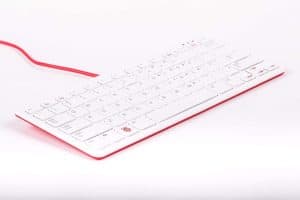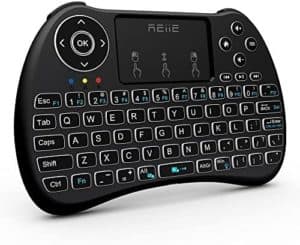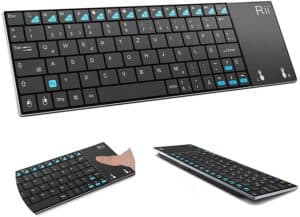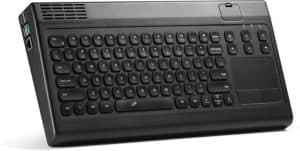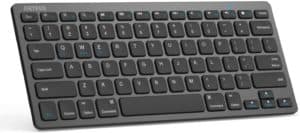Best Raspberry Pi Keyboard in 2024
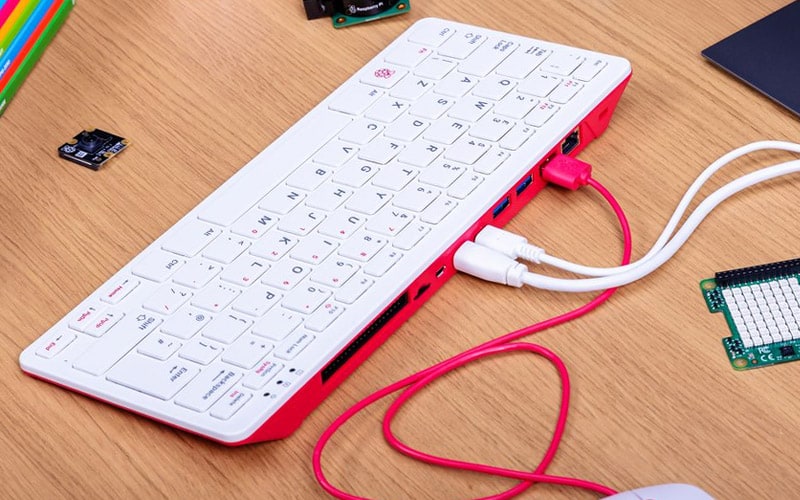
While any standard keyboard is compatible with the Raspberry Pi, there’s a market for keyboards tailored made to pair perfectly with the Pi. Part of the appeal of these keyboards is that they are designed specifically for the Raspberry Pi, not least with a typically small form factor to match the single-board computers’ diminutive size and make them suited to popular Pi applications.
They also tend to veer towards all-in-one solutions tooled for convenience with a built-in track pad, wireless connectivity, and USB ports. A full-sized keyboard would be too impractical and unwieldy for a Raspberry Pi programmed to work as a home theater setup, for example.
As with most Raspberry Pi accessories, there are quite a few options to choose from, including an official model from Raspberry Pi all the way to budget third-party keyboards. To help you wade through the selection of keyboards and settle on a winner, we’ve penned this handy guide to the best Raspberry Pi keyboards currently available.
Products at a Glance
How we picked
The factors that make a great keyboard apply to Raspberry Pi keyboards, too: size, wired or wireless connectivity, layout, ergonomics, the feel and quality of the keys, and, of course, price. We, therefore, evaluated each keyboard we came across based on these factors with a particular focus on whether they enhance or hamper using a Raspberry Pi.
Doing so allowed us to slim down our selection to five Raspberry Pi keyboards that, in our estimation, pair beautifully with the popular mini-computer. We’ve included a range of form factors, layouts, and manufacturers to offer cover as many bases as possible with an overall focus on good quality products.
Read on for a brief review of each, where we spotlight their strengths and weaknesses. Beyond that, we’ve also wedged in a ‘Things to Consider’ section at the end, where we share a few top tips to keep in mind when shopping for a Raspberry Pi keyboard.
Product Reviews
- Official Raspberry Pi product
- Thin, responsive keys
- Ergonomic design
- Three port USB hub
- Compact keyboard
- Affordable price point
- No wireless or Bluetooth functionality
Our top pick is the Raspberry Pi Official Keyboard, not least because it comes from the folks at Raspberry Pi and, as such, is designed to pair perfectly with the Raspberry Pi. Aside from the official stamp of approval, the Raspberry Pi Official Keyboard is also an ergonomically designed 79-key keyboard shrunk down to a compact form factor that efficiently balances comfort and space-saving.
The white and red or black and grey color schemes look great and complement good construction. The keys are thin and responsive, conducive to a pleasant typing experience, as suited to those penning lengthy essays or coding late into the night on their Raspberry Pi, as the occasional short burst of typing when web browsing.
The Raspberry Pi Official Keyboard handily incorporates a three USB 2.0 Type-A port hub conveniently mounted on the front-facing part of the keyboard. The positioning is ideal for adding a mouse, external hard drive, or USB dongle without encroaching on precious desk space. And, of course, the hub serves as a USB pass-through, so you’re not sacrificing a precious on-Pi USB port to use the keyboard. On the contrary, the hub expands the USB offering from four to six ports.
The only genuine complaint is that the Raspberry Pi Official Keyboard is wired and features no Wireless or Bluetooth connectivity, making it only really suitable for a desktop Pi setup. That said, the provided USB Type-A to micro USB Type-B cable offers quick plug-and-play connectivity to both the Raspberry Pi and any standard computer or laptop, meaning the Raspberry Pi Official Keyboard can double as a multiple purpose keyboard.
- Ergonomic handheld design
- Multi-finger touchpad
- 2.4 GHz wireless connectivity
- Backlit LED keys
- Media keys
- Key size
More reminiscent of a game controller than a keyboard, the REIIE H9+ is designed for those that want wireless, in-hand control over their Raspberry Pi. The keyboard adopts a compact, ergonomic handheld design that conforms well to the natural contour on the hands.
2.4 GHz wireless connectivity allows for wire-free functionality thanks to an included mini receiver dongle that plugs directly into one of the Raspberry Pi’s USB ports. The dongle has a maximum range of 15 meters, which should be more than enough for most users, and can even be stored in a bracket on the keyboard itself when not in use.
In our experience, the wireless signal is strong and doesn’t suffer from interference. A built-in Li-ion battery offers roughly a week of average use on a single charge, and charge times are nippy to boot. The keyboard also includes a power conserving sleep mode that triggers after 3 minutes of inactivity.
The REIIE H9+ features a touch pad mounted on the center of the device that handles multi-finger controls. We found it reasonably responsive and well suited to navigating any of the Raspberry Pi compatible operating systems. Alongside, there’s even a pair of controller-style triggers that work as right/left click alternatives. You’ll also find a generous selection of media controls, including volume control, play/pause/forward/rewind, and a remote-control style d-pad. The keys also have back-light LEDs, which work great in darker environments.
While the REIIE H9+ sticks to the traditional keyboard layout, the spacing of the 73 keys is very tight, and the keys themselves are small compared to a typical keyboard. Their size isn’t necessarily an issue if the keyboard is used occasionally to navigate a Raspberry Pi rigged to operate a home theater setup or for light web browsing. But, for sustained typing, the cramped layout quickly becomes challenging to work with.
- Ultra-compact, lightweight form factor
- In-built touchpad
- 2.4 GHz Wireless connectivity
- On-keyboard dongle storage
- Power on/off switch to save battery
- Aviation-grade aluminum construction
- Key size and spacing don’t deliver a great typing experience
Measuring an ultra-compact 10″ x 3.8″, the Rii K12+ is our top pick for those looking for a portable, thin form factor Raspberry Pi keyboard.
Despite its diminutive size, the Rii K12+ includes a standard keyboard layout (minus the number pad and with the function keys incorporated into the top line number keys) and a touch pad with multi-finger functions (right-click, left-click, and scroll commands). The Rii K12+ features an aviation-grade aluminum back-plate for a solid in-hand feel while still being lightweight.
2.4 GHz wireless connectivity ensures a full cordless experience. The keyboard comes with a tiny USB dongle with its own on-keyboard storage slot and offers a generous operational range of 25 meters. The 450mAh Li-ion battery guarantees about a month’s use on a single charge. There’s also a power on/off switch on the keyboard, which can help save battery life, as does the auto sleep function.
A symptom of attempting to downsize a keyboard to such a small form factor, the key size and spacing make for a cramped layout. As a consequence, the typing experience weighs down what is otherwise a well-built and feature-full keyboard. For sofa use or the occasional trot through the internet, it’s perfect. We’d suggest one of the larger, more ergonomically-geared options like the Raspberry Pi Official Keyboard for serious Pi coding.
- All-in-One Raspberry Pi keyboard and case
- Commodore 64-style design
- Touch pad
- Media keys
- Battery powered
- Requires a USB dongle despite housing the Raspberry Pi
While technically a keyboard, the Vilros 2.4GHz Keyboard and Touchpad Hub is much more in that it is also a case for the Raspberry Pi, offering an all-in-one solution for those that want all the parts of their Pi setup in one convenient unit.
It’s fair to say that the Vilros 2.4GHz Keyboard and Touchpad Hub is a chunky device that’s reminiscent of the form factor of the Commodore 64 and, as such, isn’t the most compact solution out there. Nevertheless, the larger footprint is put to good use with a special compartment with a fan designed to house a Raspberry Pi, including all models dating back to the original Pi 1, a touch pad with dedicated right/left click buttons (menu, volume, mute, etc.), and six media keys.
Installation of the Pi is exceptionally straightforward and well-guided, thanks to clear and concise instructions. You can even store an HDMI cable within the unit to help with cable management.
The Vilros 2.4GHz Keyboard and Touchpad Hub isn’t without its oddities, though. Chiefly, it runs on a pair of AAA batteries (which aren’t included with the keyboard) housed in a hard-to-reach compartment that requires lifting out the Pi to access. Furthermore, while technically wireless, the keyboard still requires a USB dongle connected to one of the USB ports on the Raspberry Pi to function.
- Low price
- Ultra-slim and lightweight design
- Bluetooth connectivity
- 4 month battery life
- Low-profile keys
- Noisy keys
- Build quality
Our top pick for those looking to buy a Raspberry Pi keyboard on a tight budget is the Arteck Ultra-Slim Bluetooth Keyboard. You get what you pay for, but when it comes to stretching $15 to the limit, this keyboard certainly delivers everything you’d need to use a Raspberry Pi.
It has an ultra-slim and lightweights design and a standard layout (minus number pad and arrow keys) with function keys doubling as media keys. The keys are of the low profile variety and deliver a pleasant on-finger feel that’s responsive and comfortable. According to Arteck, they can handle up to 3 million key presses before petering out.
Bluetooth connectivity offers an operational range of 10 meters. The included two AAA batteries deliver roughly four months of daily use before they need replacing – one of the most energy-efficient keyboards in our list by a considerable margin. There’s even an auto-sleep mode to conserve even more battery. An in-built Li-ion battery would have been a welcome feature, but at this price point and given the battery life, this isn’t too much of a negative.
Arteck describes the Arteck Ultra-Slim Bluetooth Keyboard as having ‘silent’ keys. In practice, the keys are quite noisy, which, while not an issue for most, is something to be aware of if you’re looking for quiet operation.
At under $15, we can’t expect the best build quality for the Arteck Ultra-Slim Bluetooth Keyboard. It’s a cheap and cheerful option and has the construction to match. Don’t expect this one to survive multiple drops or to be still running years down the line.
Things to consider
Size and layout
Raspberry Pi keyboards come in a variety of sizes and layouts. Typically, they are smaller than full-sized keyboards and are more akin to tenkeyless keyboards, often removing the number pad entirely. Some shrink the footprint down to no bigger than an average gaming controller.
Layouts tend to stick to the standard keyboard key arrangement, although there are more unusual formats, notably Raspberry Pi keyboards designed to be handled devices. The keys are much smaller, which may not suit those who prefer a traditional keyboard’s feel and spacing.
No size or layout is better than the others, and it rather comes down to personal preference and how and where you plan to use your Raspberry Pi. As such, buy according to your needs.
Comfort and ergonomics
As with regular PC keyboards, Raspberry Pi keyboards must be comfortable to use and offer a pleasant typing experience. Some manufacturers go to length to incorporate an ergonomic shape alongside keys that provide a responsive on-finger feel. In contrast, others opt for convenience by reducing the keyboard’s footprint at the expense of comfort. The latter variants are more suited to occasional typing rather than sustained use.
When shopping for Raspberry Pi keyboards, you’ll invariably come across handheld keyboards shaped to be held in two hands as you would a game controller. While they take some time to get used to, they are ergonomically shaped and are well suited to home theater setups or retro gaming emulators where a standard keyboard would be impractical.
Features
Built-in Track Pad – a Raspberry Pi keyboard with an integrated track pad or touch pad is a great option if having a separate mouse is a nuisance, and you want an all-in-one option that works as well at a desk as on the sofa.
USB Hub – certain Raspberry Pi keyboards feature in-built USB ports to accommodate external peripherals such as mice, external hard drives, and game controllers. Setups that need more USB ports than the four found on the Raspberry Pi 4 will benefit significantly from an on-keyboard USB hub.
Media Keys – much like traditional keyboards, media keys allow easy navigation of media such as video and music, perfect for home theater setups. Standard functions include volume control, remote control style d-pad navigation buttons, and browser navigation keys such as refresh, back, and forward.
Can Raspberry Pi use any keyboard?
Any wired USB keyboard or wireless keyboard should be compatible with the Raspberry Pi.
Can you use a wireless keyboard with Raspberry Pi?
Wireless keyboards can easily be connected to Raspberry Pis. All you need to do is insert a Bluetooth dongle into one of the USB ports.
If you’re looking for the best Bluetooth 5.0 dongles check out our guide.
Our Verdict
Nothing beats an officially made and vetted product. The Raspberry Pi Official Keyboard is our top recommendation among Raspberry Pi keyboards. An excellent typing experience merges with a comfortable ergonomic design and useful three-port USB hub, all in a compact, affordable package that pairs beautifully with all and any Raspberry Pi model.
Among handheld Raspberry Pi keyboards, our top choice is the REIIE H9+. With wireless connectivity, an ergonomic design, media keys, and a multi-finger touch pad, it has everything you need to use your Raspberry Pi from the comfort of your sofa.
The Rii K12+ makes our list for being one of the better compact Raspberry Pi keyboards out there. Lightweight and small, it still has all the features you need, including a touch pad, wireless connectivity, and excellent build quality. Not one for the avid typer, though, due to the size and spacing of the keys.
The Vilros 2.4GHz Keyboard and Touchpad Hub deviates from the rest of our recommendations in that it’s not simply a keyboard but also an all-in-one case for the Raspberry Pi that even includes a touch pad. The Commodore 64 reminiscent design should suit nostalgic gamers.
Lastly, there’s no need to spend a fortune to pick up a great Raspberry Pi, and the Arteck Ultra-Slim Bluetooth Keyboard attests to this. Slim, lightweight, wireless, and with plenty of battery life, it’s only let down by sub-par build quality.
We’ll now wrap up our guide to the best Raspberry Pi keyboards. The comments section below is open should you have any questions, suggestions, or concerns.


